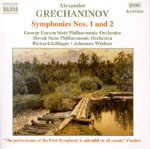Alexander Grechaninov (1864-1956) enjoyed a measure of success during his long lifetime, particularly after his emigration to the United States where his symphonies were performed by the Philadelphia Orchestra, among others. This was remarkable at a time when the avant-garde was all the rage in the musical establishment, and avant garde was something Grechaninov never could be accused of. In fact, if Grechaninov ever heard a Schoenbergian tone-row or a Stravinskian compound rhythm, or even a Debussian whole-tone scale, he made no indication of it in his music, which stayed comfortably and stubbornly in 19th-century Russia, lounging about with the likes of Balikirev and Kalinnikov. Knowing this makes it difficult to appreciate his later symphonies, but Nos. 1 & 2, written before 1910, appear to be more reasonable products of their time (that is, if we ignore Scriabin, or even Rachmaninov).
Symphony No. 1 begins with a chant-like B-minor theme that sets the tone for the following allegro movement, which, like the remaining ones, is well constructed if not especially memorable. Grechaninov makes much use of Russian folk music, both here and in the Second Symphony, a slightly more substantial and inventive work that nonetheless never rises above second-rate. Beginning with a Pastorale rather than the customary allegro, the symphony’s best movement is the Andante, with its extended clarinet meditation followed by a beautiful second theme on the strings. Both works receive equally effective performances from Richard Edlinger and the George Enescu State Philharmonic Orchestra (No. 1), and Johannes Wildner and the Slovak State Philharmonic (No. 2). The recordings were made in halls that lend their peculiar, somewhat distorting acoustic quality to the sound (and imparting a sense of nostalgia for those old Melodiya discs). If you’re a devoted fan of 19th-century Russian symphonic music, no matter when it was composed, you’ll be delighted by this release.
































